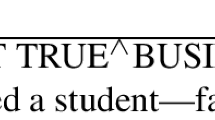Abstract
This paper investigates the strength of the local attachment preference in syntactic ambiguity resolution, based on a study of a novel ambiguity for which the predictions of local attachment contrast with the predictions of a wide range of other ambiguity resolution principles. In sentences of the form “Because Rose praised the recipe I made ...” we show that the ambiguous clause “I made” is preferentially attached as a relative clause under some circumstances, as predicted by local attachment, and preferentially attached as a matrix clause under other circumstances. The implications for accounts of locality in parsing are discussed.
Similar content being viewed by others
REFERENCES
Abney, S. (1989). A computational model of human parsing. Journal of Psycholinguistic Research, 18, 129–144.
Altmann, G., & Steedman, M. (1988). Interaction with context during human sentence processing. Cognition, 30, 191–238.
Brysbaert, M., & Mitchell, D. (1996). Modifier attachment in sentence parsing: Evidence from Dutch. Quarterly Journal of Experimental Psychology, 49, 664–695.
Clifton, C., Speer, S., & Abney, S. (1991). Parsing arguments: Phrase structure and argument structure as determinants of initial parsing decisions. Journal of Memory and Language, 30, 251–271.
Crain, S., & Steedman, M. (1985). On not being led up the garden path: the use of context by the psychological parser. In D. Dowty, L. Karttunen, & A. Zwicky (Eds.), Natural language parsing: Psychological, computational and theoretical perspectives. Cambridge, UK: Cambridge University Press.
Cuetos, F., & Mitchell, D. (1988). Cross-linguistic differences in parsing: Restrictions on the use of the late closure strategy in Spanish. Cognition, 30, 73–105.
Ferreira, F., & Clifton, C., Jr. (1986). The independence of syntactic processing. Journal of Memory and Language, 25, 348–368.
Fodor, J. D., & Frazier, L. (1983). Local attachment in a one-stage parser. Unpublished manuscript.
Ford, M., Bresnan, J. & Kaplan, R. (1982). A competence based theory of syntactic closure. In J. Bresnan (Ed.), The mental representation of grammatical relations (pp. 727–796). Cambridge, MA: MIT Press.
Frazier, L. (1978). On comprehending sentences: Syntactic parsing strategies. Unpublished doctoral dissertation, University of Connecticut.
Frazier, L. (1987). Sentence processing: A tutorial review. In M. Coltheart (Ed.), Attention and performance XII. Hillsdale, NJ: Erlbaum.
Frazier, L., & Rayner, K. (1982). Making and correcting errors during sentence comprehension: Eye movements in the analysis of structurally ambiguous sentences. Cognitive Psychology, 14, 178–210.
Gibson, E. (1991). A computational theory of human language processing: Memory limitations and processing breakdown. Unpublished doctoral dissertation, Carnegie Mellon University.
Gibson, E., & Broihier, K. (In press). Optimality theory and human sentence processing. In P. Barbosa, D. Fox, P. Hagstrom, M. McGinnis, D. Peselsky (Eds), Is the best good enough? Cambridge, MA: MIT Press.
Gibson, E., Hickok, G., & Schütze, C. (1994). Processing empty categories in a parallel parsing framework. Journal of Psycholinguistic Research, 23, 381–405.
Gibson, E., Pearlmutter, N., Canseco-Gonzalez, E., & Hickok, G. (1996). Recency preferences in the human sentence processing mechanism. Cognition, 59, 23–59.
Just, M. A., Carpenter, P. A., & Wooley, J. D. (1982). Paradigms and processes in reading comprehension. Journal of Experimental Psychology: General, 3, 228–238.
Kimball, J. (1973). Seven principles of surface structure parsing in natural language. Cognition, 2, 15–47.
Larson, R. (1988). On the double object construction. Linguistic Inquiry, 19, 335–391.
Larson, R. (1990). Double objects revisited: Reply to Jackendoff. Linguistic Inquiry, 21, 589–632.
Percus, O. (1995). A horse raced to logical form. In C. Schütze, J. Ganger, K. Broihier (Eds), Papers on Language Processing and Acquisition (pp. 473–519). (MIT Working Papers in Linguistics 26). Cambridge, MA: MITWPL.
Pesetsky, D. (1995). Zero syntax. Cambridge, MA: MIT Press.
Phillips, C. (1995). Right association in parsing and grammar. In C. Schütze, J. Ganger, K. Broihier (Eds), Papers on Language Processing and Acquisition (pp. 37–93) (MIT Working Papers in Linguistics 26). Cambridge, MA: MITWPL.
Phillips, C. (1996). Order and structure. Unpublished doctoral dissertation, MIT.
Pritchett, B. (1988). Garden-path phenomena and the grammatical basis of language processing. Language, 64, 539–576.
Pritchett, B. (1992). Grammatical competence and parsing performance. Chicago, IL: University of Chicago Press.
Rayner, K., Carlson, M., & Frazier, L. (1983). The interaction of syntax and semantics during sentence processing: Eye-movements in the analysis of semantically biased sentences. Journal of Verbal Learning and Verbal Behavior, 22, 358–374.
Schütze, C., & E. Gibson. (1996, March). Argumenthood and PP-attachment. Poster presented at the Ninth Annual CUNY Conference on Sentence Processing, New York.
Spivey-Knowlton, M., & Sedivy, J. (1995). Resolving attachment ambiguities with multiple constraints. Cognition, 55, 227–267.
Stowe, L. (1986). Evidence for on-line gap location. Language and Cognitive Processes, 1, 227–245.
Stroik, T. (1990). Adverbs as V-sisters. Linguistic Inquiry, 21, 654–661.
Townsend, D., & Bever, T. (1978). Interclause relations and clausal processing. Journal of Verbal Learning and Verbal Behavior, 17, 509–521.
Trueswell, J. C., & Tanenhaus, M. K. (1991). Tense, temporal context and syntactic ambiguity resolution. Language and Cognitive Processes, 6, 303–338.
Author information
Authors and Affiliations
Rights and permissions
About this article
Cite this article
Phillips, C., Gibson, E. On the Strength of the Local Attachment Preference. J Psycholinguist Res 26, 323–346 (1997). https://doi.org/10.1023/A:1025028725042
Issue Date:
DOI: https://doi.org/10.1023/A:1025028725042



